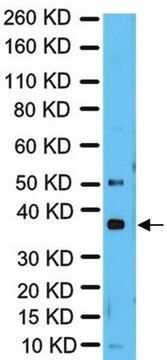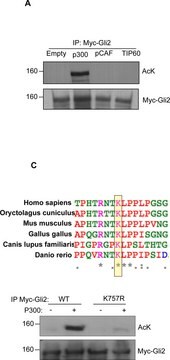07-1781
Anti-RAD50 Antibody
from rabbit, purified by affinity chromatography
Synonym(e):
RAD50 (S. cerevisiae) homolog, RAD50 homolog, RAD50 homolog (S. cerevisiae)
About This Item
Empfohlene Produkte
Biologische Quelle
rabbit
Qualitätsniveau
Antikörperform
affinity isolated antibody
Antikörper-Produkttyp
primary antibodies
Klon
polyclonal
Aufgereinigt durch
affinity chromatography
Speziesreaktivität
human
Speziesreaktivität (Voraussage durch Homologie)
rat, mouse
Methode(n)
immunocytochemistry: suitable
western blot: suitable
NCBI-Hinterlegungsnummer
UniProt-Hinterlegungsnummer
Versandbedingung
wet ice
Posttranslationale Modifikation Target
unmodified
Angaben zum Gen
human ... RAD50(10111)
mouse ... Rad50(19360)
Allgemeine Beschreibung
Spezifität
Immunogen
Anwendung
Epigenetik & nukleäre Funktionen
Transkriptionsfaktoren
A 1:500 dilution of this antibody was used to detect RAD50 on HeLa and A431 cells.
Qualität
A 1:500 dilution of this antibody was used to detect RAD50 on human spleen lysate.
Zielbeschreibung
Physikalische Form
Lagerung und Haltbarkeit
To reconstitute the antibody, centrifuge the antibody at a moderate speed (5,000 rpm) for 5 minutes. Carefully remove the ammonium sulfate/PBS buffer solution and discard; 10μL of residual ammonium sulfate solution will not affect the re-suspension of the antibody. Do not let the protein pellet dry, as severe loss of antibody reactivity can occur. Re-suspend the antibody pellet in 100L either standard PBS or TBS (pH 7.3-7.5). DO NOT VORTEX. Mix by gentle stirring with a wide pipet tip or gentle finger-tapping. Let the precipitated antibody rehydrate for 1 hour at 4-25°C prior to use. Small particles of precipitated antibody that fail to re-suspend are normal. Vials are overfilled to compensate for any losses.
Hinweis zur Analyse
Human spleen lysate.
Haftungsausschluss
Sie haben nicht das passende Produkt gefunden?
Probieren Sie unser Produkt-Auswahlhilfe. aus.
Lagerklassenschlüssel
12 - Non Combustible Liquids
WGK
WGK 2
Flammpunkt (°F)
Not applicable
Flammpunkt (°C)
Not applicable
Analysenzertifikate (COA)
Suchen Sie nach Analysenzertifikate (COA), indem Sie die Lot-/Chargennummer des Produkts eingeben. Lot- und Chargennummern sind auf dem Produktetikett hinter den Wörtern ‘Lot’ oder ‘Batch’ (Lot oder Charge) zu finden.
Besitzen Sie dieses Produkt bereits?
In der Dokumentenbibliothek finden Sie die Dokumentation zu den Produkten, die Sie kürzlich erworben haben.
Unser Team von Wissenschaftlern verfügt über Erfahrung in allen Forschungsbereichen einschließlich Life Science, Materialwissenschaften, chemischer Synthese, Chromatographie, Analytik und vielen mehr..
Setzen Sie sich mit dem technischen Dienst in Verbindung.








